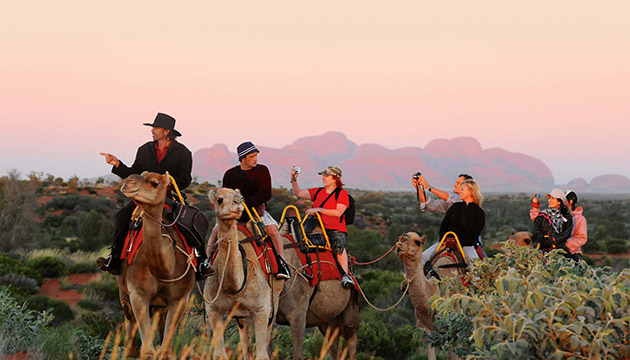Australia’s centre glows with iconic landforms and warm-hearted characters.
Story By Kerry Sharp
Some camels lead pretty easy lives these days, when you consider what their forebears went through. Australia’s first ‘ships of the desert’ were imported in the 1840s to plod into the great unknown, weighed down by flour bags, picks, shovels and other burdensome cargo that our early explorers needed to help them tame the wild interior.
By comparison, the 40 dromedaries at Uluru Camel Tours only work a few hours a day, carrying passengers to witness sunrise and sunset over the world’s most famous rock – then retire to graze and doze until duty calls again. The cameleers speak to them tenderly by name and know their personalities intimately. Special favourites are ‘Old Tom’, the grandfather of the group at age 40, and two bright-eyed babies. Everyone working with the camels, including joint owners Mark Swindells and Chris Hill, has had long and happy relationships with camels all over Australia.
Perched on a descendant of the Red Centre’s pioneering camels while waiting for the sun to rise, you can’t help but reflect on the age and enormity of Uluru. Its cultural links date back tens of thousands of years before the first white man witnessed its imposing presence on the landscape. The World Heritage-listed Uluru-Kata Tjuta National Park is roughly halfway along the Red Centre Way that follows Larapinta and Namatjira drives, Luritja Road and the Lasseter Highway that meets the Stuart Highway and takes you back to Alice. It is an exceptional drive, retracing the tracks of pioneering overlanders who first recorded the landmarks that have made Central Australia an internationally acclaimed travel destination.
The journey takes in Australia’s most revered desert icons – Uluru, Kata Tjuta, Kings Canyon and many spectacular landmarks in between. It loops through the traditional lands of the Western Arrernte people whose cultural ties remain strong and proud after more than 40,000 years as custodians of the region.
This story excerpt is from Issue #81
Outback Magazine: Feb/Mar 2012










